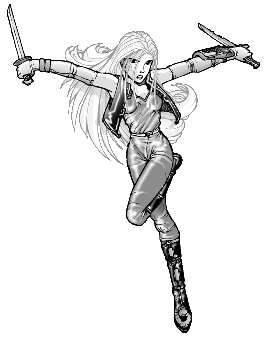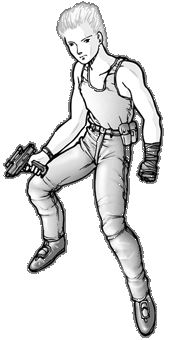

(Homo sapiens lamina)
Elite, agile combat operatives and assassins.
Avg. Height: M - 5'2" F - 5'
Avg. Weight: M - 125# F - 100#
Hair Color: Blonde, light brown, white
Eye Color: Light blue, green, pink
Blood Pressure: 110/70
Life Expectancy: 90 years
Dist. Marks: Pale skin, slender build, slightly disproportionate frame
|
Spectres are the ultimate disposable heroes, created with the agility and
intelligence necessary to infiltrate, assassinate and then die.
As the original ragers were being phased out for various reasons, the
Americorp military decided that it needed a smaller, skilled warrior who
could continue acts of surreptitious aggression, even on foreign ground.
Rather than sending in an army of battle suited behemoths, they could use
one soldier to independently and infiltrate enemy territory in order to
achieve the same end goal. Using genetic science developed in the creation
of the ragers, this smaller breed of soldier was soon ready for "Special
Covert Ops," and it wasn't long after seeing action that these pale, frail,
wraithlike operatives were dubbed spectres.
Because of the strict height and weight requirements for the spectre
program, approximately 85 to 90% of all existing spectres are female, since
they tend to fit the profile (maximum 5'4", 150#) more readily. However,
this is particularly true even among the few male spectres, since they tend
to enroll in the program near age 13, when as legal adults in Americorp
society they are both mature enough to make an informed decision on the
matter and young enough to adapt well to the procedures and genetic
manipulation that will decrease their growth rate and increase their
capabilities as elite combat operatives.
The spectre's small frame is designed to enhance their quickness, stealth
and accuracy. Shorter limbs give them a smaller movement arc, and a higher
number of fast twitch muscles provides lightning fast striking ability.
Inside, some nerves are widened to produce faster movements and reaction
times during the short, intense bursts of activity that they are noted for.
Other nerves are "hard-wired" to create permanently open combative reflex
arcs, while others are altered so as to diminish the pain spectres feel,
especially when they are in the midst of combat: a broken ankle would feel
like a stubbed toe, and electrical torture would feel like walking barefoot
over a fuzzy rug. Powerful leg muscles, flatter feet and more weight at the
bottom provide far superior balance, more powerful kicking ability and the
ability to run faster for short periods of time. Looser, more flexible
joints and tendons allow a greater range of motion, and the ability to slip
through bars or break bonds if necessary. Even their altered ribcage is
stronger and more flexible, but provides less space for fatty tissue; hence,
female spectres tend to have smaller breasts.
During stress situations, a spectre's body is genetically modified to
produce boosted levels of hemoglobin, combining with involuntary
hyperventilation to hyperoxygenate the blood, which is then flooded with
hormones and chemicals like adrenaline/epinephrine, L-dopa, and endorphins.
At the same time, their normally low blood pressure is boosted to nearly
200/150, while the blood vessels to the limbs constrict (thanks in part to
the vasoconstrictive effects of epinephrine) as those to the brain widen.
Known as "blood redistribution," this has two main effects. First of all, it
lessens the amount of blood lost if a spectre is cut in the midst of combat.
Secondly, it results in an increased bloodflow to the brain, improving
reaction time and augmenting the senses. This, along with a higher number of
rods in their eyes, allows spectres to see in near darkness, making out fine
details and color differences when they are in a hypersensitive state.
Interestingly, this is heightened even further by the fact that most female
spectres (85%) are tetrachromatic, meaning that their retinas carry extra
rods allowing them to discern a wider range of color than most humans within
the red-green spectrum.
The effects of the spectre's "combat mode" are at best unpleasant, and at
their worst can be quite fatal. For starters, even though spectres normally
have a body temperature of around 95 degrees, they often begin to feel
feverish and get headaches as blood throbs into their brains, while at the
same time their skin grows not only paler but cold to the touch as
capillaries constrict and blood moves away from their fingers and toes.
Pressure to the brain for extended periods of time can also cause
hallucinations, disrupt motor skills, and wreak havoc on the nervous system.
The mental flood as the brain hyperrecords events during the "rush" of
battle can make it difficult to remember details, such as who was killed, or
where the spectre fled to afterwards. Thirty minutes of on-again, off-again
combat and a spectre may pass out.
A more serious risk involved with redistribution of blood to the head is a
condition known as "red out" (as opposed to the more familiar "black out");
where black out is a lack of blood to the brain, red out is an excess. The
visual warning of red out, a reddening of vision as blood is forced into the
retinas, is normally not harmful in itself, but repeated periods of extreme
blood flow to the brain can cause hemorrhaging, strokes, excruciating
headaches and unconsciousness. Even assuming the spectre survives combat, he
or she may start bleeding severely before clotting can begin if the
previously blood-drained limbs suffered any serious cuts during combat. As
the spectre may feel lightheaded, dizzy and even giddy while the blood
shifts back to where it belongs, and their fever breaks and their body
starts to sweat away foul-smelling chemicals, they might very well be unable
to patch even a relatively small wound, and could easily bleed to death.
Because of their generally low blood pressure and reduced flow of blood to
their extremities, spectres are not at all adapted to cold climates. Even a
brisk breeze on a warm spring day might give them a chill, and temperatures
below freezing might very well bring on frostbite if protective gear is not
worn. Because of their small build, childbirth is difficult, and because
many spectre children are small and have low blood pressure there is a high
infant mortality rate. Although they remain young-looking until well into
their 50s, adult spectres also have problems after middle age. Bones get
brittle and arthritis sets in, causing many to suffer a lingering, painful
death. Their unique skin chemistry also causes a variety of problems, as
spectres suffer the effects of photoaging after repeated and prolonged
exposure to the sun. The skin becomes coarse, wrinkled, and leathery with
uneven pigmentation and a tendency to develop skin cancers. Every day is
also a struggle to maintain the proper diet; the over-efficient metabolism
of a spectre means that they suffer from low blood sugar after a fight, and
need to eat almost immediately or suffer from hypoglycemia. But if they eat
as much as a normal human, they will quickly grow fat. They can eat candy
all day long, but even one hamburger will cause weight gain.
This can also serve them well, however, since the ability to quickly alter
their shape gives them an advantage when it comes to disguise. A seven foot
tall rager cannot pretend to be a five foot tall woman, but a spectre can be
anything or anyone with the right padding, platform shoes, makeup and
perfume or, given a few days, a few dozen hamburgers. The spectre's unique
skin also adds to their disguise capabilities, their normally pale color
capable of being darkened to allow a spectre to mimic any skin color from
white to black. This is possible due to the fact that spectres can generate
unlimited quantities of melanin; whereas normal skin can only produce a
certain amount of melanin each day, allowing only a limited amount of
tanning, the longer spectres are exposed to sunlight, the darker they tan. A
pale-skinned spectre can tan dark brown or black in just a few hours,
without burning, the disguise lasting for a period of 3 to 10 days and
easily finished off with hair dye and colored contact lenses. After this
time, the top layers of skin peel off, leaving the spectre with whitish skin
once again.
In part because their clothing tends to hide differences better, female
spectres tend to be slightly better at disguise than males, although many
male spectres have become skilled at crossdressing as part of their disguise
options (a sore point for some, a source of self-deprecating amusement for
others). This and other non-combat skills ultimately means that spectres are
much more employable than ragers, and as such they tend to enjoy a healthier
lifestyle and better support from human society. On the one hand, much like
ex-Navy SEALS, Green Berets, SAS, KGB and ninja, spectres are always able to
find work as spies, scouts, assassins and covert "specialists" of all sorts,
even if their original employers don't need them. However, spectres also
find themselves at home in non-combat situations as well, finding work as
quite versatile actors or performers to be quite easy for them. Others use
their innate cunning and improved senses to do battle in a more corporate
setting, although even then they can never quite leave their pasts entire
behind them. The way a spectre's body reacts to stress often causes them to
suffer nervous attacks when experiencing stressful situations, and snapping
and trying to murder your CEO in the middle of a stressful meeting in the
boardroom does not exactly go over well. At times like this a spectre's
ability to disguise and disappear comes in quite handy.

INSPIRATIONAL IDEAS
Music: Jazz
Stories: "The Professional," "La Femme Nikita," "Aeon Flux," "Ronin"
Quote: "Those who know how to win are far more numerous than those who know
how to make proper use of their victories." --Polybius
Stats:
* Higher than average Physical & Mental Agility.
* Below average Physical Endurance & Strength.
Pros:
* Small size and agility gives Spectres an edge in melee combat.
* Spectres are highly biased toward disguise, easily changing their
appearance.
* Spectres conserve energy well, and need to eat, drink and sleep less than
other genos.
Cons:
* Spectres are not built for long combats, or sustaining heavy damages.
* Spectres are typically distrusted by many, often for good reason.
|











